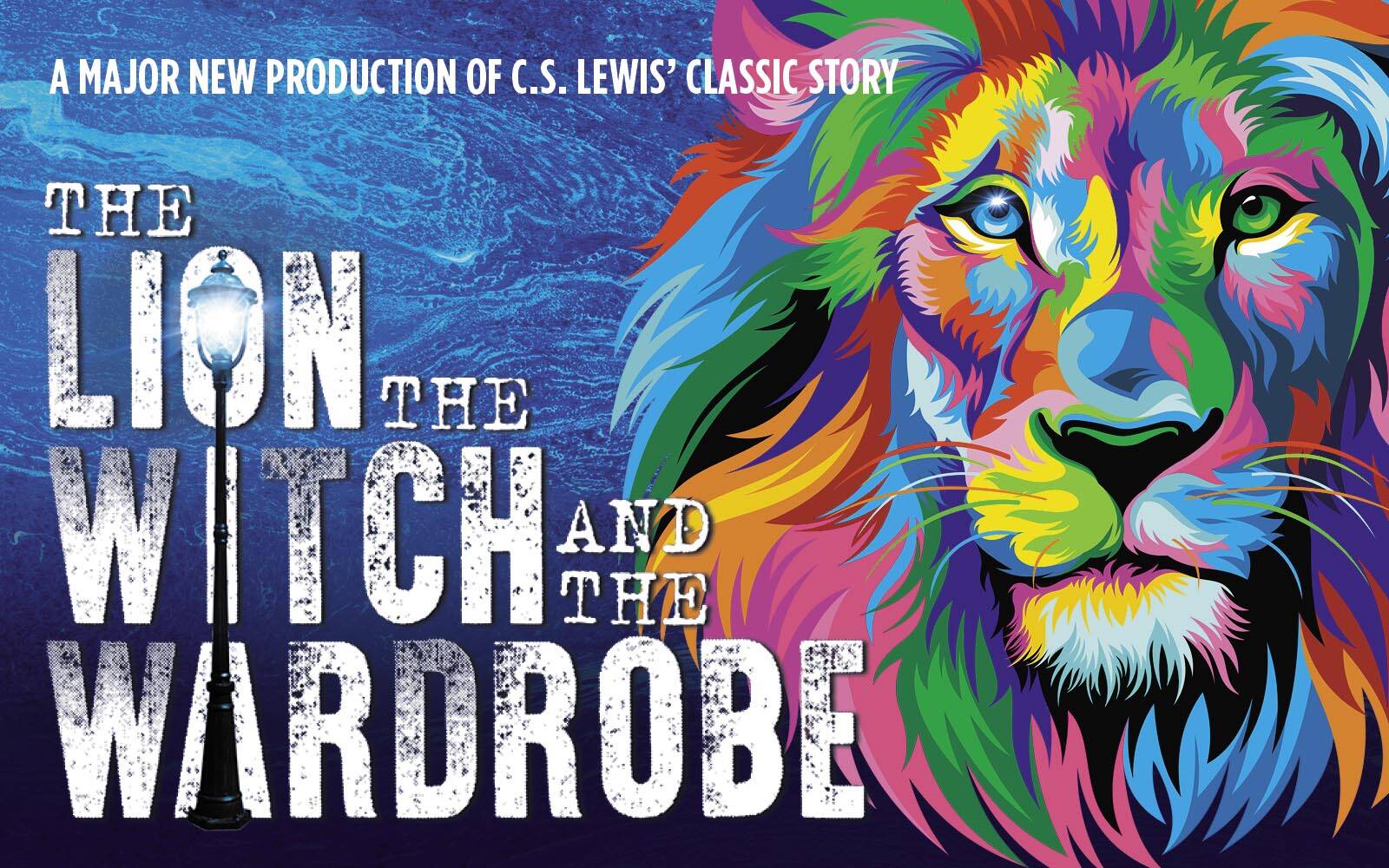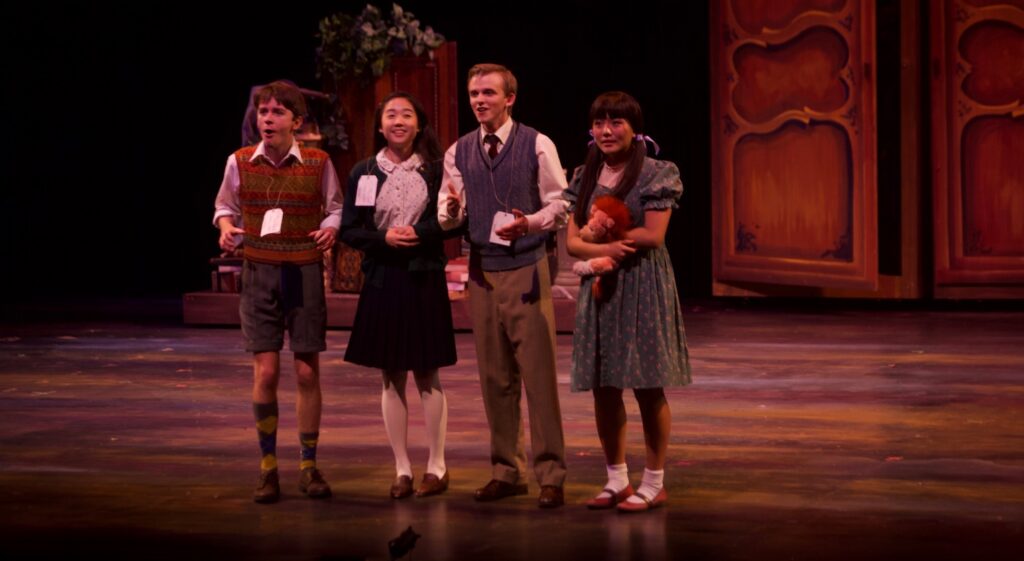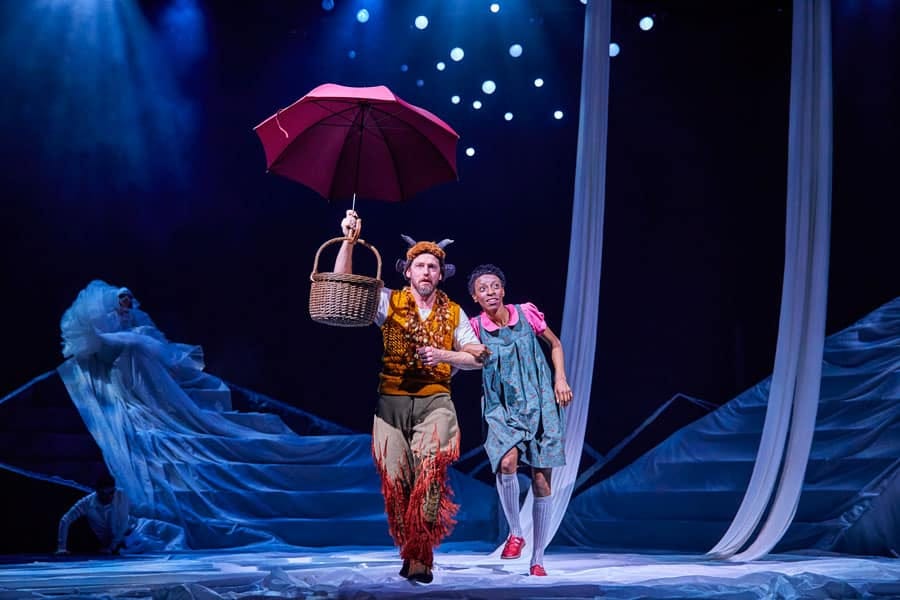
The Lion, the Witch, and the Wardrobe Theatre Delight
Enter a world of wonder and magic as we delve into the captivating theatre adaptation of C.S. Lewis’s timeless classic, “The Lion, the Witch, and the Wardrobe.” This enchanting production has brought the beloved tale to life on stage, promising a theatrical experience like no other. Join us on a journey through Narnia as we uncover the mesmerizing elements that make this theatre rendition a must-see.
Act 1: Setting the Stage

In the opening act of the theatrical spectacle that is “The Lion, the Witch, and the Wardrobe,” the stage is transformed into a portal of enchantment. As the curtains rise, the audience is immediately drawn into the magic of Narnia. The set design, a visual masterpiece in itself, serves as the gateway to a world where ordinary wardrobes become extraordinary portals:
- The attention to detail in the set design is nothing short of commendable. From the woodwork of the wardrobe to the snowy landscapes of Narnia, every element is meticulously crafted to transport the audience into the heart of the story. The wardrobe itself, a seemingly ordinary piece of furniture, takes on a life of its own, becoming a symbol of the fantastical journey that awaits;
- The lighting design plays a pivotal role in creating the ambiance of Narnia. As the Pevensie siblings stumble upon the wardrobe, the lighting subtly shifts, signaling the transition from the mundane to the magical. The use of warm hues bathes the stage in a golden glow, evoking a sense of wonder and anticipation. Conversely, as the characters venture deeper into Narnia’s winter realm, a cool blue palette envelops the stage, adding to the otherworldly atmosphere;
- The set transitions are seamless, a dance of choreographed movement that mirrors the characters’ journey through different realms. The transformation of the wardrobe into the gateway to Narnia is a moment of theatrical brilliance. Ingenious stagecraft, coupled with creative use of lighting and sound, elevates this moment into a magical spectacle that leaves the audience in awe;
- Costume design further enhances the visual feast. The Pevensie siblings’ attire evolves with the unfolding narrative, mirroring their growth and transformation within Narnia. Aslan’s majestic presence is accentuated by a costume that exudes regality and strength, while the White Witch’s ethereal and chilling ensemble captures the essence of her character.
The set, lighting, and costume design collectively create a visual symphony, setting the stage for a theatrical experience that transcends the boundaries of the ordinary. The audience is not merely watching a play; they are being transported into a world where wardrobes hold the key to extraordinary adventures. Act 1 succeeds in captivating the audience’s senses, igniting their imagination, and laying the foundation for the magical journey that unfolds in the acts to come.
Act 2: The Ensemble Cast Shines

As the curtains close on Act 1, the spotlight now turns to the true heartbeat of any theatrical production – the ensemble cast. In “The Lion, the Witch, and the Wardrobe,” each member of the cast becomes a vital thread in the intricate tapestry of Narnia’s enchanting narrative:
- The chemistry among the Pevensie siblings is palpable from the moment they step onto the stage. The dynamics between Peter, Susan, Edmund, and Lucy are portrayed with authenticity, capturing the essence of sibling relationships with all its quirks and camaraderie. The actors seamlessly embody the growth and transformation of their characters, navigating the challenges and discoveries of Narnia with conviction;
- However, it’s not just the Pevensie siblings who steal the spotlight. The iconic characters of Aslan, the noble lion, and the enigmatic White Witch, contribute significantly to the production’s success. Aslan, portrayed with regal dignity and a hint of vulnerability, commands the stage with a presence that transcends the physical realm. The actor’s delivery brings depth to Aslan’s wisdom, making the character a beacon of strength and guidance;
- Conversely, the White Witch exudes an otherworldly charm and a chilling aura. The actor’s portrayal captures the dichotomy of the character – a captivating presence masking a malevolent intent. The scenes between the White Witch and the Pevensie siblings crackle with tension, creating a captivating dynamic that keeps the audience on the edge of their seats;
- The supporting characters, from Mr. Tumnus to the mythical creatures of Narnia, contribute to the richness of the ensemble. Their performances, though brief in some instances, leave a lasting impression, adding layers to the magical world unfolding on stage. The seamless interaction between the main characters and the supporting cast enhances the overall cohesiveness of the ensemble;
- The success of the ensemble cast can be attributed not only to the individual talents of the actors but also to the directorial guidance that ensures a harmonious collaboration. The blocking and choreography showcase the characters’ relationships and emotions, creating visually compelling scenes that resonate with the audience;
- Moreover, the cast’s ability to navigate the complexities of live theatre, from projecting their voices to conveying emotions through facial expressions, is commendable. The audience is not merely observing a performance; they are drawn into the characters’ journeys, experiencing the highs and lows alongside them.
In Act 2, the ensemble cast shines as a collective force, breathing life into C.S. Lewis’s beloved characters. Their performances elevate the production, making the audience emotionally invest in the fate of Narnia. As the story unfolds, it becomes clear that the success of “The Lion, the Witch, and the Wardrobe” on stage rests on the shoulders of these talented actors, who bring magic to life with each line, expression, and movement.
Act 3: Special Effects Spectacle

As the enchanting narrative of “The Lion, the Witch, and the Wardrobe” progresses, Act 3 unfolds as a breathtaking spectacle of special effects. In this act, the magic of Narnia comes to life through innovative use of technology, practical effects, and a commitment to creating a visual feast that captivates the audience’s imagination:
- The production team’s mastery of special effects is evident from the moment the wardrobe becomes a portal to Narnia. The seamless transition, enhanced by a combination of lighting, sound, and stagecraft, is a testament to the creativity and technical expertise behind the scenes. The gasps of wonder from the audience echo the success of this magical transformation;
- As the characters journey through Narnia, the special effects play a pivotal role in bringing the fantastical elements of C.S. Lewis’s world to the stage. From the mythical creatures to the enchanting landscapes, every detail is meticulously crafted to transport the audience into the heart of the narrative. The use of projection mapping and holographic displays adds a layer of depth to the visual experience, blurring the lines between reality and fantasy;
- One of the standout moments is the epic battle scenes. The clash between Aslan’s forces and the White Witch’s army is a symphony of choreography and special effects. The use of pyrotechnics, controlled lighting, and well-timed sound effects creates a sensory overload that immerses the audience in the intensity of the conflict. The magic wielded by characters is brought to life through dazzling displays of light and color, leaving the audience in awe of the spectacle unfolding before them;
- Transformation scenes are another highlight of the special effects showcase. Whether it’s characters morphing from human to mythical beings or the ever-shifting landscapes of Narnia, the technical precision is nothing short of impressive. The marriage of practical effects, such as meticulously designed costumes and props, with cutting-edge technology ensures that each transformation is a visual feast;
- The magic, however, isn’t limited to grandiose displays. Small, subtle touches, like the ethereal glow of magical objects or the fluttering of fairy wings, contribute to the overall enchantment. The attention to detail in these moments adds layers to the narrative, making the magical elements an integral part of the storytelling rather than mere embellishments.
The success of Act 3 lies not just in the individual special effects but in their seamless integration into the broader narrative. The effects enhance the emotional beats of the story, creating a visceral connection between the audience and the characters. As the curtains fall on this act, the lingering sense of wonder in the air is a testament to the special effects team’s ability to turn the fantastical into a tangible, awe-inspiring experience for the audience.
Act 4: Captivating Storytelling
As Act 4 unfolds, the spotlight shifts from the visual spectacle to the beating heart of any great theatrical production – captivating storytelling. In “The Lion, the Witch, and the Wardrobe,” the narrative prowess takes center stage, weaving a spellbinding tale of courage, friendship, and the eternal struggle between good and evil:
- The adaptation skillfully navigates the intricate tapestry of C.S. Lewis’s classic, staying true to the source material while infusing a fresh energy that resonates with both avid fans and newcomers. The pacing is deliberate, allowing the audience to savor every moment of the characters’ journey through Narnia. The script strikes a balance between the whimsical charm of a fairy tale and the profound themes that underlie the narrative;
- At its core, the story revolves around the Pevensie siblings – Peter, Susan, Edmund, and Lucy. Act 4 delves deep into their individual growth arcs, portraying the challenges they face, the lessons they learn, and the bonds that strengthen with each trial. The character development is nuanced, with the actors delivering performances that breathe life into the beloved characters;
- The themes of sacrifice, redemption, and the triumph of good over evil resonate powerfully throughout Act 4. Aslan’s sacrificial act becomes a poignant moment that tugs at the audience’s heartstrings, while the Pevensie siblings’ journey from uncertainty to bravery adds layers to the narrative. The emotional highs and lows are expertly navigated, creating a rollercoaster of feelings that keeps the audience engaged and invested in the characters’ fates;
- The dialogue, a fusion of Lewis’s prose and the adaptational brilliance of the scriptwriters, is both witty and profound. Memorable quotes from the source material are seamlessly integrated, adding a touch of nostalgia for those familiar with the book while providing new audiences with thought-provoking insights. The interplay of words becomes a powerful tool in conveying the emotions and motivations that drive the characters forward;
- The narrative arc of the White Witch, a formidable antagonist, adds complexity to the story. Act 4 peels back the layers of her character, revealing the motivations behind her actions. The dynamic between the White Witch and the Pevensie siblings becomes a psychological chess game, heightening the tension and creating a sense of urgency that propels the story forward;
- Musical accompaniment, a silent but powerful storyteller, underscores the emotional beats of the narrative. The original compositions, coupled with familiar melodies, enhance the atmospheric richness of the production. The synergy between storytelling and music is evident in key moments, creating an immersive experience that lingers in the minds of the audience.
In Act 4, captivating storytelling takes the reins, steering the audience through a journey of self-discovery, bravery, and the enduring power of hope. The narrative craftsmanship, combined with stellar performances, ensures that “The Lion, the Witch, and the Wardrobe” transcends the confines of a mere stage performance, becoming a theatrical odyssey that leaves a lasting impression on the hearts of those fortunate enough to witness it.
Act 5: Musical Magic

As the grand finale approaches, Act 5 of “The Lion, the Witch, and the Wardrobe” unfolds as a symphony of musical magic that elevates the theatrical experience to new heights. In this act, the power of music becomes a driving force, enhancing emotional resonance, amplifying key moments, and leaving an indelible mark on the audience:
- The musical score, a delicate fusion of original compositions and familiar melodies, serves as an emotional guide throughout the production. From the opening notes to the final crescendo, the music becomes a character in itself, weaving through the narrative with precision and purpose. Each melody is carefully chosen to complement the mood of the scenes, creating an auditory landscape that enhances the visual spectacle;
- Original compositions breathe life into Narnia, with thematic motifs that capture the essence of the characters and the fantastical world they inhabit. Aslan’s theme, regal and powerful, heralds the presence of the noble lion. The White Witch’s motif, haunting and ethereal, mirrors her sinister nature. These musical cues become a storytelling device, evoking emotions and signaling shifts in the narrative;
- Familiar melodies from C.S. Lewis’s world, whether adapted from the source material or composed for previous adaptations, provide a nostalgic thread that connects the stage production to the broader legacy of Narnia. The audience, especially those familiar with the books, finds comfort and familiarity in these musical echoes, deepening their engagement with the story;
- The live orchestra, an unsung hero of the production, adds a layer of authenticity to the musical experience. The swell of strings, the thundering percussion, and the delicate interplay of instruments transport the audience into the heart of the action. The musicians, hidden from view, become the invisible architects of the emotional journey, syncing their craft with the actors on stage;
- Musical numbers, whether vocal or instrumental, become pivotal moments of the production. From lively tunes that accompany the Pevensie siblings’ adventures to soul-stirring ballads that capture the emotional core of the narrative, the songs serve as a vehicle for storytelling. The choreography, synchronized with the music, creates visual poetry that enhances the overall impact of these musical interludes;
- The synergy between music and narrative peaks in moments of emotional intensity. As characters face trials, make sacrifices, or experience moments of triumph, the music swells in harmony, heightening the emotional impact. The cathartic power of a well-timed musical crescendo transforms Act 5 into an emotional rollercoaster, leaving the audience on the edge of their seats.
The magic of Act 5 lies not just in the individual musical pieces but in their collective ability to transport the audience. The musical magic becomes a binding force, unifying the visual, auditory, and emotional elements of the production. As the final notes echo through the theater, the audience is left not just with the memory of a play but with a melodic journey through the enchanting realms of Narnia.
Conclusion
As the final curtain descends, the applause reverberates through the theatre, a testament to the success of “The Lion, the Witch, and the Wardrobe” on stage. This production has managed to capture the hearts of both fans of the classic tale and newcomers alike. The seamless blend of exceptional performances, stunning visuals, and a faithful adaptation of the source material make this theatre rendition a triumph in every sense. Whether you’re a Narnia enthusiast or a casual theatre-goer, this magical journey is an experience you won’t soon forget.